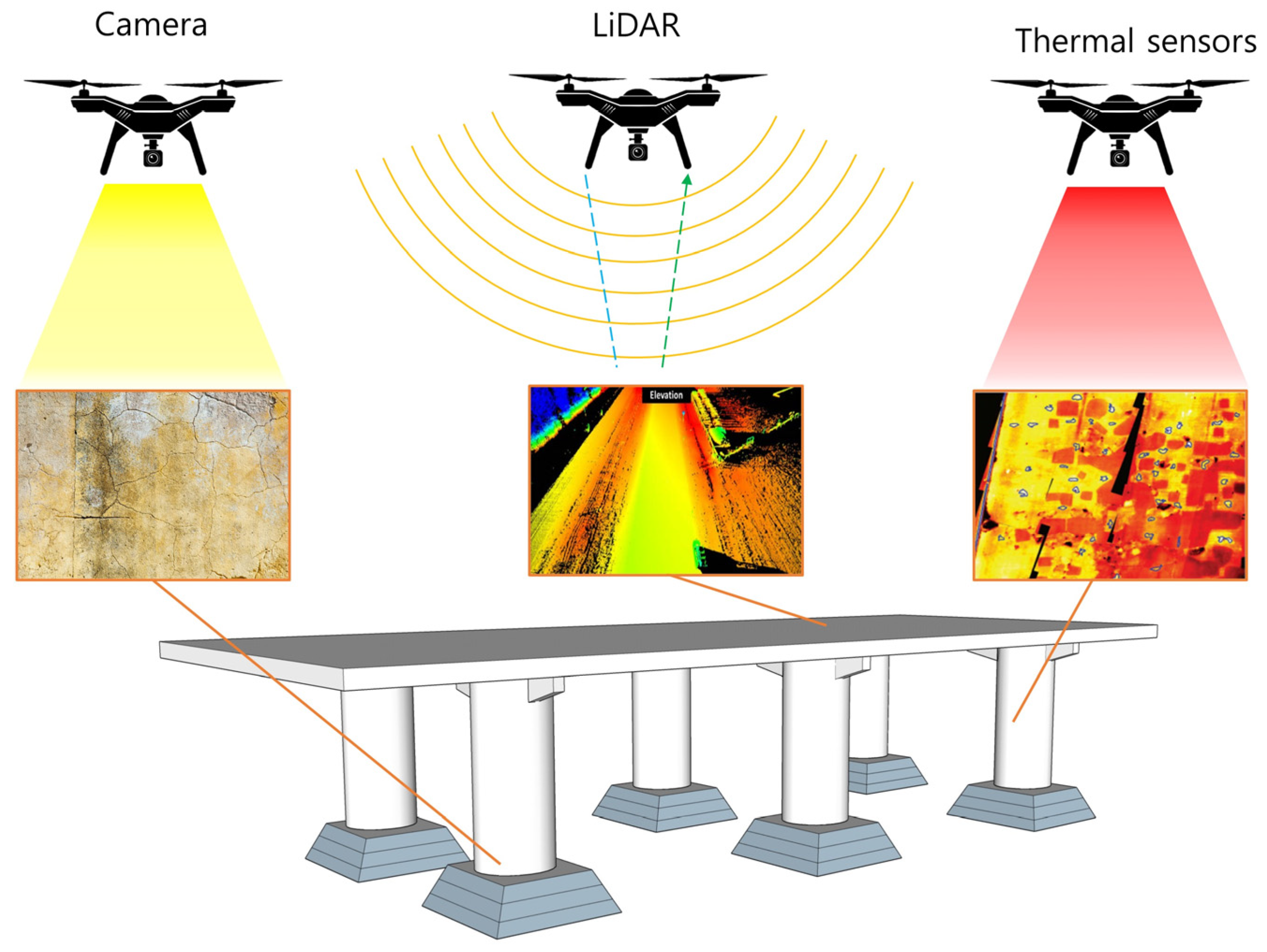An Overview of Drone Applications in the Construction Industry
Abstract
1. Introduction
2. Drone Types for Application in Construction Industry
2.1. Fixed-Wing Drones
2.2. Rotary-Wing Drones
2.3. Hybrid Drones
3. Drone Application during the Designing Phase of Construction
3.1. Suitable Site Selection
3.2. Land Surveying and Mapping
4. Drone Application during the Construction Phase
4.1. Earthwork and Grading Monitoring
4.2. Quality Control and Progress Monitoring
4.3. Safety Monitoring
4.4. Material Tracking and Delivery
5. Drone Application during the Maintenance Phase
5.1. High Resolution Camera-Based Inspection with Drone
5.2. Drone Equipped with LiDAR for Structure Maintenance
5.3. Drones Equipped with Thermal Camera for Structure Maintenance
6. Challenges and Opportunities
7. Future Directions
8. Conclusions
Author Contributions
Funding
Institutional Review Board Statement
Informed Consent Statement
Data Availability Statement
Conflicts of Interest
References
- Shanti, M.Z.; Cho, C.S.; de Soto, B.G.; Byon, Y.J.; Yeun, C.Y.; Kim, T.Y. Real-time monitoring of work-at-height safety hazards in construction sites using drones and deep learning. J. Saf. Res. 2022, 83, 364–370. [Google Scholar] [CrossRef]
- Zhang, Y.; Zhang, K. Design of Construction Site Dust Detection System Based on UAV Flying Platform. In Proceedings of the IEEE International Conference on Control Science and Electric Power Systems (CSEPS), Shanghai, China, 28–30 May 2021; pp. 148–151. [Google Scholar]
- Olivatto, T.F.; Inguaggiato, F.F.; Stanganini, F.N. Urban mapping and impacts assessment in a Brazilian irregular settlement using UAV-based imaging. Remote Sens. Appl. Soc. Environ. 2023, 29, 100911. [Google Scholar]
- Fan, J.; Saadeghvaziri, M.A. Applications of drones in infrastructures: Challenges and opportunities. Int. J. Mech. Mechatron. Eng. 2019, 13, 649–655. [Google Scholar]
- Tao, C.; Zhu, K.; Chen, B.; Zhao, Y. UAV-assisted ground signal map construction based on 3-D spatial correlation. In Proceedings of the GLOBECOM 2020—2020 IEEE Global Communications Conference, Taipei, Taiwan, 7–11 December 2020; pp. 1–5. [Google Scholar]
- Tatum, M.C.; Liu, J. Unmanned aircraft system applications in construction. Procedia Eng. 2017, 196, 167–175. [Google Scholar] [CrossRef]
- Liu, Q.; Chen, B.; Yan, Y.; Zhang, C. A measurement method for construction planning and completion based on UAV photography. In Proceedings of the 2022 4th International Conference on Intelligent Control, Measurement and Signal Processing (ICMSP), Hangzhou, China, 8–10 July 2022; pp. 148–151. [Google Scholar]
- Zhang, C.; Wang, F.; Zou, Y.; Dimyadi, J.; Guo, B.H.; Hou, L. Automated UAV image-to-BIM registration for building façade inspection using improved generalised Hough transform. Autom. Constr. 2023, 153, 104957. [Google Scholar] [CrossRef]
- Hamledari, H.; Sajedi, S.; McCabe, B.; Fischer, M. Automation of Inspection Mission Planning Using 4D BIMs and in Support of Unmanned Aerial Vehicle–Based Data Collection. J. Constr. Eng. Manag. 2021, 147, 04020179. [Google Scholar] [CrossRef]
- Ruiz, R.D.B.; Lordsleem, A.C., Jr.; Rocha, J.H.A.; Irizarry, J. Unmanned Aerial Vehicles (UAV) as a Tool for Visual Inspection of Building Facades in AEC+FM Industry. Constr. Innov. 2021, 22, 1155–1170. [Google Scholar] [CrossRef]
- Petritoli, E.; Leccese, F.; Ciani, L. Reliability Degradation, Preventive and Corrective Maintenance of UAV Systems. In Proceedings of the 2018 5th IEEE International Workshop on Metrology for AeroSpace (MetroAeroSpace), Rome, Italy, 20–22 June 2018; pp. 430–434. [Google Scholar]
- Sowing UAV of Fixed Wings. Available online: https://www.uavos.com/products/fixed-wing-uavs/sitaria-e/ (accessed on 15 June 2023).
- Sowing UAV of Quadcopter. Available online: https://www.ubuy.dk/en/product/1E71NHFK-dji-air-2s-drone-quadcopter-uav-with-3-axis-gimbal-camera-5-4k-video-1-inch-cmos-sensor-4-directions (accessed on 8 June 2023).
- Sowing UAV of Hexacopter. Available online: https://www.best-quadcopter.com/reviews/2017/03/yuneec-typhoon-h-pro-realsense-obstacle-avoiding-drone/ (accessed on 28 June 2023).
- Sowing UAV of Octocoptor. Available online: https://kr.made-in-china.com/co_agriculture-drone/image_30L-Payload-RC-8-Propellers-Professional-Plant-Protection-Drone_eeeessrsy_2f1j00AkmWNvsHpOrU.html (accessed on 1 June 2023).
- Sowing UAV of Hybrid. Available online: https://www.viewprouav.com/product/tiger-shark-f380-heavy-lift-hybrid-vtol-fixed-wing-with-3-8m-wingspan-10kg-load-capacity.html (accessed on 3 June 2023).
- Calantropio, A.; Chiabrando, F.; Sammartano, G.; Spanò, A.; Teppati Losè, L. UAV Strategies validation and remote sensing data for damage assessment in post-disaster scenarios. Int. Arch. Photogramm. Remote Sens. Spat. Inf. Sci. 2018, 42, 121–128. [Google Scholar] [CrossRef]
- Villanueva, J.R.E.; Martínez, L.I.; Montiel, J.I.P. DEM Generation from Fixed-Wing UAV Imaging and LiDAR-Derived Ground Control Points for Flood Estimations. Sensors 2019, 19, 3205. [Google Scholar]
- Templin, T.; Popielarczyk, D.; Kosecki, R. Application of Low-Cost Fixed-Wing UAV for Inland Lakes Shoreline Investigation. Pure Appl. Geophys. 2018, 175, 3263–3283. [Google Scholar] [CrossRef]
- Anders, N.; Masselink, R.; Keesstra, S.; Suomalainen, J. High-Res Digital Surface Modeling using Fixed-Wing UAV-based Photogrammetry. In Proceedings of the Geomorphometry 2013, Nanjing, China, 16–20 October 2013; pp. 2–5. [Google Scholar]
- Yi, W.; Liming, C.; LingYu, K.; Jie, Z.; Miao, W. Research on application mode of large fixed-wing UAV system on overhead transmission line. In Proceedings of the IEEE International Conference on Unmanned Systems (ICUS), Beijing, China, 27–29 October 2017; pp. 88–91. [Google Scholar]
- El Tin, F.; Sharf, I.; Nahon, M. Fire Monitoring with a Fixed-wing Unmanned Aerial Vehicle. In Proceedings of the 2022 International Conference on Unmanned Aircraft Systems (ICUAS), Dubrovnik, Croatia, 21–24 June 2022; pp. 1350–1358. [Google Scholar]
- Sonkar, S.; Kumar, P.; George, R.C.; Yuvaraj, T.P.; Philip, D.; Ghosh, A.K. Real-time object detection and recognition using fixed-wing Lale VTOL UAV. IEEE Sens. J. 2022, 22, 20738–20747. [Google Scholar] [CrossRef]
- Khan, S.; Bendoukha, S.; Naeem, W.; Iqbal, J. Experimental validation of an integral sliding mode-based LQG for the pitch control of a UAV-mimicking platform. Adv. Electr. Electron. Eng. 2019, 17, 275–284. [Google Scholar]
- Chae, M.H.; Park, S.O.; Choi, S.H.; Choi, C.T. Commercial Fixed-Wing Drone Redirection System using GNSS Deception. IEEE Trans. Aerosp. Electron. Syst. 2023, 1–15. [Google Scholar] [CrossRef]
- Sujit, P.B.; Saripalli, S.; Sousa, J.B. Unmanned Aerial Vehicle Path Following: A Survey and Analysis of Algorithms for Fixed-Wing Unmanned Aerial Vehicless. IEEE Control Syst. Mag. 2014, 34, 42–59. [Google Scholar]
- Jin, J.W.; Miwa, M.; Shim, J.H. Design and construction of a Quad tilt-Rotor UAV using servo motor. J. Eng. Educ. Res. 2014, 17, 17–22. [Google Scholar]
- Yang, H.; Lee, Y.; Jeon, S.-Y.; Lee, D. Multi-rotor drone tutorial: Systems, mechanics, control and state estimation. Intell. Serv. Robot. 2017, 10, 79–93. [Google Scholar] [CrossRef]
- Altınuç, K.O.; Khan, M.U.; Iqbal, J. Avoiding contingent incidents by quadrotors due to one or two propellers failure. PLoS ONE 2023, 18, e0282055. [Google Scholar] [CrossRef]
- Freimuth, H.; König, M. Planning and Executing Construction Inspections with Unmanned Aerial Vehicles. Autom. Constr. 2018, 96, 540–553. [Google Scholar] [CrossRef]
- Kim, S.S. Opportunities for construction site monitoring by adopting first personal view (FPV) of a drone. Smart Struct. Syst. 2018, 21, 139–149. [Google Scholar]
- Deng, C.; Wang, S.; Huang, Z.; Tan, Z.; Liu, J. Unmanned Aerial Vehicles for power line inspection: A cooperative way in platforms and communications. J. Commun. 2014, 9, 687–692. [Google Scholar] [CrossRef]
- Boon, M.A.; Drijfhout, A.P.; Tesfamichael, S. Comparison of a fixed-wing and multi-rotor UAV for environmental mapping applications: A case study. Int. Arch. Photogramm. Remote Sens. Spat. Inf. Sci. 2017, 42, 47. [Google Scholar]
- Thibbotuwawa, A.; Bocewicz, G.; Radzki, G.; Nielsen, P.; Banaszak, Z. UAV Mission Planning Resistant to Weather Uncertainty. Sensors 2020, 20, 515. [Google Scholar] [CrossRef] [PubMed]
- Eck, C.; Imbach, B. Aerial magnetic sensing with an UAV helicopter. Int. Arch. Photogramm. Remote Sens. Spat. Inf. Sci. 2011, 38, 81–85. [Google Scholar] [CrossRef]
- Li, X.; Wu, J. Extracting High-Precision Vehicle Motion Data from Unmanned Aerial Vehicle Video Captured under Various Weather Conditions. Remote Sens. 2022, 14, 5513. [Google Scholar] [CrossRef]
- Al-Rawabdeh, A.; He, F.; Moussa, A.; El-Sheimy, N.; Habib, A. Using an Unmanned Aerial Vehicle-Based Digital Imaging System to Derive a 3D Point Cloud for Landslide Scarp Recognition. Remote Sens. 2016, 8, 95. [Google Scholar] [CrossRef]
- Jacob-Loyola, N.; Munoz-La Rivera, F.; Herrera, R.F.; Atencio, E. Unmanned aerial vehicles (uavs) for physical progress monitoring of construction. Sensors 2021, 21, 4227. [Google Scholar] [CrossRef] [PubMed]
- Motawa, I.; Kardakou, A. Unmanned aerial vehicles (UAVs) for inspection in construction and building industry. In Proceedings of the the 16th International Operation and Maintenance Conference, Cairo, Egypt, 18–20 November 2018. [Google Scholar]
- Khaloo, A.; Lattanzi, D.; Cunningham, K.; Dell’Andrea, R.; Riley, M. Unmanned aerial vehicle inspection of the Placer River Trail Bridge through image-based 3D modelling. Struct. Infrastruct. Eng. 2018, 14, 124–136. [Google Scholar] [CrossRef]
- Lindner, G.; Schraml, K.; Mansberger, R.; Hübl, J. Uav monitoring and documentation of a large landslide. Appl. Geomat. 2016, 8, 1–11. [Google Scholar] [CrossRef]
- Panigrahi, S.; Krishna, Y.S.S.; Thondiyath, A. Design, Analysis, and Testing of a Hybrid VTOL Tilt-Rotor UAV for Increased Endurance. Sensors 2021, 21, 5987. [Google Scholar] [CrossRef]
- Gunarathna, J.K.; Munasinghe, R. Development of a quad-rotor fixed-wing hybrid unmanned aerial vehicle. In Proceedings of the 2018 Moratuwa Engineering Research Conference (MERCon), Moratuwa, Sri Lanka, 30 May–1 June 2018; pp. 72–77. [Google Scholar]
- Saeed, A.S.; Younes, A.B.; Cai, C.; Cai, G. A Survey of Hybrid Unmanned Aerial Vehicles. Prog. Aerosp. Sci. 2018, 98, 91–105. [Google Scholar] [CrossRef]
- Yuksek, B.; Vuruskan, A.; Ozdemir, U.; Yukselen, M.A.; Inalhan, G. Transition flight modeling of a fixed-wing VTOL UAV. J. Intell. Robot. Syst. 2016, 84, 83–105. [Google Scholar] [CrossRef]
- Nguyen, K.D.; Ha, C.; Jang, J.T. Development of a new hybrid drone and software-in-the-loop simulation using px4 code. In Intelligent Computing Theories and Application, Proceedings of the International Conference on Intelligent Computing, Wuhan, China, 15–18 August 2018; Springer: Cham, Switzerland, 2018; pp. 84–93. [Google Scholar]
- Asadi, K.; Kalkunte Suresh, A.; Ender, A.; Gotad, S.; Maniyar, S.; Anand, S.; Noghabaei, M.; Han, K.; Lobaton, E.; Wu, T. An integrated UGV-UAV system for construction site data collection. Autom. Constr. 2020, 112, 103068. [Google Scholar] [CrossRef]
- Congress, S.S.C.; Puppala, A.J. A Road Map for Geotechnical Monitoring of Transportation Infrastructure Assets Using Three-Dimensional Models Developed from Unmanned Aerial Data. Indian Geotech. J. 2021, 51, 84–96. [Google Scholar] [CrossRef]
- Bang, S.; Kim, H.; Kim, H. UAV-Based Automatic Generation of High-Resolution Panorama at a Construction Site with a Focus on Preprocessing for Image Stitching. Autom. Constr. 2017, 84, 70–80. [Google Scholar] [CrossRef]
- Kim, P.; Park, J.; Cho, Y. As-Is Geometric Data Collection and 3D Visualization through the Collaboration between UAV and UGV. In Proceedings of the 36th International Symposium on Automation and Robotics in Construction (ISARC), Banff, AB, Canada, 21–24 May 2019; Al-Hussein, M., Ed.; International Association for Automation and Robotics in Construction (IAARC): Banff, AB, Canada, 2019; pp. 544–551. [Google Scholar]
- Giordan, D.; Adams, M.S.; Aicardi, I.; Alicandro, M.; Allasia, P.; Baldo, M.; De Berardinis, P.; Dominici, D.; Godone, D.; Hobbs, P.; et al. The use of unmanned aerial vehicles (UAVs) for engineering geology applications. Bull. Int. Assoc. Eng. Geol. 2020, 79, 3437–3481. [Google Scholar] [CrossRef]
- Bemis, S.P.; Micklethwaite, S.; Turner, D.; James, M.R.; Akciz, S.; Thiele, S.T.; Bangash, H.A. Ground-based and UAV-Based photogrammetry: A multi-scale, high-resolution mapping tool for structural geology and paleoseismology. J. Struct. Geol. 2014, 69, 163–178. [Google Scholar] [CrossRef]
- Westoby, M.J.; Brasington, J.; Glasser, N.F.; Hambrey, M.J.; Reynolds, J. Structure-from-Motion’photogrammetry: A low-cost, effective tool for geoscience applications. Geomorphology 2012, 179, 300–314. [Google Scholar] [CrossRef]
- Ajayi, O.G.; Palmer, M.; Salubi, A.A. Modelling farmland topography for suitable site selection of dam construction using unmanned aerial vehicle (UAV) photogrammetry. Remote Sens. Appl. Soc. Environ. 2018, 11, 220–230. [Google Scholar]
- Dominici, D.; Alicandro, M.; Massimi, V. Uav photogrammetry in the post-earthquake scenario: Case studies in l’aquila. Geomat. Nat. Hazards Risk 2017, 8, 87–103. [Google Scholar] [CrossRef]
- Park, J.; Im, S.; Lee, K.H.; Lee, J.O. Vision-based SLAM system for small UAVs in GPS-denied environments. J. Aerosp. Eng. 2012, 25, 519–529. [Google Scholar] [CrossRef]
- Chesley, J.T.T.; Leier, A.L.L.; White, S.; Torres, R. Using unmanned aerial vehicles and structure-from-motion photogrammetry to characterize sedimentary outcrops: An example from the Morrison Formation, Utah, USA. Sediment. Geol. 2017, 354, 1–8. [Google Scholar]
- Hammad, A.W.A.; da Costa, B.B.F.; Soares, C.A.P.; Haddad, A.N. The Use of Unmanned Aerial Vehicles for Dynamic Site Layout Planning in Large-Scale Construction Projects. Buildings 2021, 11, 602. [Google Scholar] [CrossRef]
- Han, K.K.; Golparvar-Fard, M. Potential of Big Visual Data and Building Information Modeling for Construction Performance Analytics: An Exploratory Study. Autom. Constr. 2017, 73, 184–198. [Google Scholar] [CrossRef]
- Siebert, S.; Teizer, J. Mobile 3D mapping for surveying earthwork projects using an unmanned aerial vehicle(UAV) system. Autom. Constr. 2014, 41, 1–14. [Google Scholar] [CrossRef]
- Razzaq, S.; Xydeas, C.; Mahmood, A.; Ahmed, S.; Ratyal, N.I.; Iqbal, J. Efficient optimization techniques for resource allocation in UAVs mission framework. PLoS ONE 2023, 18, e0283923. [Google Scholar] [CrossRef]
- Han, Y.; Feng, D.; Wu, W.; Yu, X.; Wu, G.; Liu, J. Geometric shape measurement and its application in bridge construction based on UAV and terrestrial laser scanner. Autom. Constr. 2023, 151, 104880. [Google Scholar] [CrossRef]
- Keyvanfar, A.; Shafaghat, A.; Rosley, M.S. Performance comparison analysis of 3D reconstruction modeling software in construction site visualization and mapping. Int. J. Archit. Computing. 2022, 20, 453–475. [Google Scholar]
- Jiménez-Jiménez, S.I.; Ojeda-Bustamante, W.; Marcial-Pablo, M.; Enciso, J. Digital Terrain Models Generated with Low-Cost UAV Photogrammetry: Methodology and Accuracy. ISPRS Int. J. Geo-Inf. 2021, 10, 285. [Google Scholar]
- Baker, W.J., III; Meehan, C.L. Spatial Interpolation of UAV Survey Data for Lift Thickness Determination during Earthwork Construction. In Proceedings of the Geo-Congress 2023, Los Angeles, CA, USA, 26–29 March 2023; pp. 336–346. [Google Scholar]
- Kim, J.; Lee, S.; Seo, J.; Lee, D.-E.; Choi, H. The Integration of Earthwork Design Review and Planning Using UAV-Based Point Cloud and BIM. Appl. Sci. 2021, 11, 3435. [Google Scholar] [CrossRef]
- Kavaliauskas, P.; Židanavičius, D.; Jurelionis, A. Geometric Accuracy of 3D Reality Mesh Utilization for BIM-Based EarthworkQuantity Estimation Workflows. ISPRS Int. J. Geo-Inf. 2021, 10, 399. [Google Scholar] [CrossRef]
- Hasegawa, H.; Sujaswara, A.A.; Kanemoto, T.; Tsubota, K. Possibilities of Using UAV for Estimating Earthwork Volumes during Process of Repairing a Small-Scale Forest Road, Case Study from Kyoto Prefecture, Japan. Forests 2023, 14, 677. [Google Scholar] [CrossRef]
- Rachmawati, T.S.N.; Park, H.C.; Kim, S. A Scenario-Based Simulation Model for Earthwork Cost Management Using Unmanned Aerial Vehicle Technology. Sustainability 2023, 15, 503. [Google Scholar]
- Park, H.C.; Rachmawati, T.S.N.; Kim, S. UAV-Based High-Rise Buildings Earthwork Monitoring—A Case Study. Sustainability 2022, 14, 10179. [Google Scholar] [CrossRef]
- Ostrovskyi, A.; Kolb, I.; Vivat, A.; Lozynskyi, V.; Zhyvchuk, V. Simplified method of obtaining data for calculating the volume of earthworks based on aerial survey materials from UAVs. In Proceedings of the International Conference of Young Professionals «GeoTerrace-2021», Lviv, Ukraine, 4–6 October 2021; Volume 1, pp. 1–5. [Google Scholar]
- Kim, D.; Liu, M.; Lee, S.; Kamat, V.R. Remote proximity monitoring between mobile construction resources using camera-mounted UAVs. Autom. Constr. 2019, 99, 168–182. [Google Scholar] [CrossRef]
- Kim, D.; Yin, K.; Liu, M.; Lee, S.; Kamat, V.R. Feasibility of a Drone-Based On-Site Proximity Detection in an Outdoor Construction Site. In Proceedings of the ASCE International Workshop on Computing in Civil Engineering 2017, Seattle, WA, USA, 25–27 June 2017; pp. 392–400. [Google Scholar]
- Wu, J.; Peng, L.; Li, J.; Zhou, X.; Zhong, J.; Wang, C.; Sun, J. Rapid safety monitoring and analysis of foundation pit construction using unmanned aerial vehicle images. Autom. Constr. 2021, 128, 103706. [Google Scholar]
- Kim, Y.H.; Shin, S.S.; Lee, H.K.; Park, E.S. Field Applicability of Earthwork Volume Calculations Using Unmanned Aerial Vehicle. Sustainability 2022, 14, 9331. [Google Scholar]
- Lee, K.; Lee, W.H. Earthwork Volume Calculation, 3D Model Generation, and Comparative Evaluation Using Vertical and High-Oblique Images Acquired by Unmanned Aerial Vehicles. Aerospace 2022, 9, 606. [Google Scholar] [CrossRef]
- Lee, S.B.; Han, D.; Song, M. Calculation and Comparison of Earthwork Volume Using Unmanned Aerial Vehicle Photogrammetry and Traditional Surveying Method. Sens. Mater. 2022, 34, 4737–4753. [Google Scholar]
- Ajayi, O.G.; Ajulo, J. Investigating the Applicability of Unmanned Aerial Vehicles (UAV) Photogrammetry for the Estimation ofthe Volume of Stockpiles. Quaest. Geogr. 2021, 40, 25–38. [Google Scholar] [CrossRef]
- Astor, Y.; Utami, R.; Gustaman, F.A.; Ramdani, M.A.; Pangestu, Y.I. Implementation of Unmanned Aerial Vehicle (UAV) in the Sand Mine Project. In Conference on Broad Exposure to Science and Technology 2021 (BEST 2021); Atlantis Press: Amsterdam, The Netherlands, 2022; pp. 66–71. [Google Scholar]
- Villalobos, N.; Alzraiee, H. Earthwork Surface Creation and Volume Computation Using UAV 3D Mapping. In Proceedings of the Construction Research Congress 2022, Arlington, VA, USA, 9–12 March 2022; pp. 1243–1252. [Google Scholar]
- Subramaniam, T.R.; Suhaimi, N.N.A.; Paizol, A.; Nor, A.H.M. Determination of Slope Stability using (UAV) Unmanned Aerial Vehicle. Multidiscip. Appl. Res. Innov. 2022, 3, 292–301. [Google Scholar]
- Pasternak, G.; Zaczek-Peplinska, J.; Pasternak, K.; Jóźwiak, J.; Pasik, M.; Koda, E.; Vaverková, M.D. Surface Monitoring of an MSW Landfill Based on Linear and Angular Measurements, TLS, and LIDAR UAV. Sensors 2023, 23, 1847. [Google Scholar]
- Cho, J.; Lee, J.; Lee, B. Application of UAV Photogrammetry to Slope-Displacement Measurement. KSCE J. Civ. Eng. 2022, 26, 1904–1913. [Google Scholar]
- Kielhauser, C.; Manzano, R.R.; Hoffman, J.J.; Adey, B.T. Automated Construction Progress and Quality Monitoring for Commercial Buildings with Unmanned Aerial Systems: An Application Study from Switzerland. Infrastructures 2020, 5, 98. [Google Scholar]
- Meshram, K.; Reddy, N.G. Development of a machine learning-based drone system for management of construction sites. In Advances in Sustainable Materials and Resilient Infrastructure; Springer: Singapore, 2022; pp. 77–78. [Google Scholar]
- Irizarry, J.; Costa, D.B. Exploratory study of potential applications of unmanned aerial systems for construction management tasks. J. Manag. Eng. 2016, 32, 05016001. [Google Scholar]
- Ngadiman, N.; Kaamin, M.; Nizam, M.A.H.M.; Johar, M.A.H.; Roslin, M.A. Unmanned aerial vehicle (UAV) visual monitoring in construction. Ann. Rom. Soc. Cell Biol. 2021, 25, 3097–3104. [Google Scholar]
- Keyvanfar, A.; Shafaghat, A.; Awanghamat, A. Optimization and Trajectory Analysis of Drone’s Flying and Environmental Variables for 3D Modelling the Construction Progress Monitoring. Int. J. Civ. Eng. 2021, 20, 363–388. [Google Scholar]
- Qu, T.; Zang, W.; Peng, Z.; Liu, J.; Li, W.; Zhu, Y.; Zhang, B.; Wang, Y. Construction Site Monitoring using UAV Oblique Phtogrammetry and BIM Technologies. In Proceedings of the 22nd CAADRIA Conference, Suzhou, China, 5–8 April 2017. [Google Scholar]
- Cheng, T.; Teizer, J. Real-time resource location data collection and visualization technology for construction safety and activity monitoring applications. Autom. Constr. 2013, 34, 3–15. [Google Scholar]
- Yang, J.; Park, M.W.; Vela, P.A.; Golparvar-Fard, M. Construction Performance Monitoring via Still Images, Time-Lapse Photos, and Video Streams: Now, Tomorrow, and the Future. Adv. Eng. Inform. 2015, 29, 211–224. [Google Scholar]
- Martinez, J.G.; Gheisari, M.; Alarcón, L.F. UAV integration in current construction safety planning and monitoring process: Case study of a high-rise building construction project in Chile. J. Manag. Eng. 2020, 36, 05020005. [Google Scholar]
- Mavroulis, S.; Andreadakis, E.; Spyrou, N.I.; Antoniou, V.; Skourtsos, E.; Papadimitriou, P.; Kasssaras, I.; Kaviris, G.; Tselentis, G.A.; Voulgaris, N.; et al. UAV and GIS based rapid earthquake-induced building damage assessment and methodology for EMS-98 isoseismal map drawing: The June 12, 2017 mw 6.3 lesvos (northeastern aegean, greece) earthquake. Int. J. Disaster Risk Reduct. 2019, 37, 20. [Google Scholar]
- Candigliota, E.; Immordino, F. Low Altitude Remote Sensing by UAV for monitoring and emergency management on historical heritage. In Proceedings of the ANIDIS Congress, Padova, Italy, 30 June–4 July 2013; Volume 30. [Google Scholar]
- Feroz, S.; Abu Dabous, S. UAV-Based Remote Sensing Applications for Bridge Condition Assessment. Remote Sens. 2021, 13, 1809. [Google Scholar] [CrossRef]
- Duque, L.; Seo, J.; Wacker, J. Bridge Deterioration Quantification Protocol Using UAV. J. Bridge Eng. 2018, 23, 04018080. [Google Scholar] [CrossRef]
- Aliyari, M.; Ashrafi, B.; Ayele, Y.Z. Hazards identification and risk assessment for UAV–assisted bridge inspections. Struct. Infrastruct. Eng. 2022, 18, 412–428. [Google Scholar] [CrossRef]
- Wackwitz, K.; Boedecker, H. Safety Risk Assessment for UAV Operation; Drone Industry Insights: Hamburg, Germany, 2015. [Google Scholar]
- Namian, M.; Khalid, M.; Wang, G.; Turkan, Y. Revealing safety risks of unmanned aerial vehicles in construction. Transp. Res. Rec. 2021, 2675, 03611981211017134. [Google Scholar] [CrossRef]
- Calamoneri, T.; Corò, F.; Mancini, S. A Realistic Model to Support Rescue Operations After an Earthquake via UAVs. IEEE Access 2022, 10, 6109–6125. [Google Scholar] [CrossRef]
- Oubbati, O.S.; Badis, H.; Rachedi, A.; Lakas, A.; Lorenz, P. Multi-UAV Assisted Network Coverage Optimization for Rescue Operations using Reinforcement Learning. In Proceedings of the 2023 IEEE 20th Consumer Communications & Networking Conference (CCNC), Las Vegas, NV, USA, 8–11 January 2023; pp. 1003–1008. [Google Scholar]
- Horyna, J.; Baca, T.; Walter, V.; Albani, D.; Hert, D.; Ferrante, E.; Saska, M. Decentralized swarms of unmanned aerial vehicles for search and rescue operations without explicit communication. Auton. Robot. 2023, 47, 77–93. [Google Scholar] [CrossRef]
- Du, Y. Multi-UAV Search and Rescue with Enhanced A Algorithm Path Planning in 3D Environment. Int. J. Aerosp. Eng. 2023, 2023, 8614117. [Google Scholar]
- Tu´snio, N.; Wróblewski, W. The Efficiency of Drones Usage for Safety and Rescue Operations in an Open Area: A Case from Poland. Sustainability 2022, 14, 327. [Google Scholar]
- Lygouras, E.; Santavas, N.; Taitzoglou, A.; Tarchanidis, K.; Mitropoulos, A.; Gasteratos, A. Unsupervised Human Detection withan Embedded Vision System on a Fully Autonomous UAV for Search and Rescue Operations. Sensors 2019, 19, 3542. [Google Scholar]
- Feraru, V.A.; Andersen, R.E.; Boukas, E. Towards an Autonomous UAV-Based System to Assist Search and Rescue Operations in Man Overboard Incidents. In Proceedings of the 2020 IEEE International Symposium on Safety, Security, and Rescue Robotics (SSRR), Abu Dhabi, United Arab Emirates, 4–6 November 2020; pp. 57–64. [Google Scholar]
- Dong, J.; Ota, K.; Dong, M. UAV-Based Real-Time Survivor Detection System in Post-Disaster Search and Rescue Operations. IEEE J. Miniaturization Air Space Syst. 2021, 2, 209–219. [Google Scholar] [CrossRef]
- Martinez-Alpiste, I.; Golcarenarenji, G.; Wang, Q.; Alcaraz-Calero, J.M. Search and rescue operation using UAVs: A case study. Expert Syst. Appl. 2021, 178, 114937. [Google Scholar]
- Goodrich, M.A.; Cooper, J.L.; Adams, J.A.; Humphrey, C.; Zeeman, R.; Buss, B.G. Using a mini-uav to support wilderness search and rescue: Practices for human-robot teaming. In Proceedings of the 2007 IEEE International Workshop on Safety, Security and Rescue Robotics, Rome, Italy, 27–29 September 2007. [Google Scholar]
- Koubaa, A.; Ammar, A.; Abdelkader, M.; Alhabashi, Y.; Ghouti, L. AERO: AI-Enabled Remote Sensing Observation with OnboardEdge Computing in UAVs. Remote Sens. 2023, 15, 1873. [Google Scholar]
- Anhammer, A.; Lundeberg, H. Autonomous UAV Path Planning Using RSS Signals in Search and Rescue Operations. Master’s Thesis, Linköping University, Linköping, Sweden, 2022. [Google Scholar]
- Kalatzis, N.; Avgeris, M.; Dechouniotis, D.; Papadakis-Vlachopapadopoulos, K.; Roussaki, I.; Papavassiliou, S. Edge computing in IoT ecosystems for UAV-enabled early fire detection. In Proceedings of the 2018 IEEE International Conference on Smart Computing (SMARTCOMP), Taormina, Italy, 18–20 June 2018; pp. 106–114. [Google Scholar]
- Van Persie, M.; Oostdijk, A.; Fix, J.; Van Sijl, M.C.; Edgardh, L. Real-time UAV based geospatial video integrated into the fire brigades crisis management GIS system. Int. Arch. Photogramm. Remote Sens. Spat. Inf. Sci. 2012, 38, 173–175. [Google Scholar] [CrossRef]
- Daniel, K.; Wietfeld, C. Using Public Network Infrastructures for UAV Remote Sensing in Civilian Security Operations; Technical University Dortmund: Dortmund, Germany, 2011. [Google Scholar]
- Moumgiakmas, S.S.; Samatas, G.G.; Papakostas, G.A. Computer Vision for Fire Detection on UAVs—From Software to Hardware. Future Internet 2021, 13, 200. [Google Scholar] [CrossRef]
- Merino, L.; Caballero, F.; Martínez-de Dios, J.; Ollero, A. Cooperative fire detection using Unmanned Aerial Vehicles. In Proceedings of the 2005 IEEE International Conference on Robotics and Automation, Barcelona, Spain, 18–22 April 2005; pp. 1884–1889. [Google Scholar]
- Seo, S.H.; Choi, J.I.; Song, J. Secure Utilization of Beacons and UAVs in Emergency Response Systems for Building Fire Hazard. Sensors 2017, 17, 2200. [Google Scholar] [PubMed]
- Kumarapu, K.; Shashi, M.; Keesara, V.R. UAV in Construction Site Monitoring and Concrete Strength Estimation. J. Indian Soc. Remote Sens. 2020, 49, 619–627. [Google Scholar] [CrossRef]
- Anwar, N.; Najam, F.A.; Izhar, M.A. Construction monitoring and reporting using drones and unmanned aerial vehicles (UAVs). In Proceedings of the Tenth International Conference on Construction in the 21st Century (CITC-10), Colombo, Sri lanka, 2–4 July 2018. [Google Scholar]
- Jo, D.; Kwon, Y. Development of Rescue Material Transport UAV (Unmanned Aerial Vehicle). World J. Eng. Technol. 2017, 5, 720–729. [Google Scholar] [CrossRef]
- Huang, Y.; Han, H.; Zhang, B.; Su, X.; Gong, Z. Supply distribution center planning in UAV-based logistics networks for post-disaster supply delivery. In Proceedings of the 2020 IEEE International Conference on E-health Networking, Application & Services (HEALTHCOM), Shenzhen, China, 1–2 March 2021; pp. 1–6. [Google Scholar]
- Wenjian, Z.; Sidong, Z.; RongJie, C.; Jingchang, X.; Yeqian, L.; Huiru, C. Design of a relief materials delivery system based on UAV. IOP Conf. Ser. Mater. Sci. Eng. 2020, 715, 012049. [Google Scholar] [CrossRef]
- Zhang, J.; Zhu, Y.; Wang, T.; Wang, W.; Wang, R.; Li, X. An Improved Intelligent Auction Mechanism for Emergency Material Delivery. Mathematics 2022, 10, 2184. [Google Scholar] [CrossRef]
- Zhang, R.; Dou, L.; Xin, B.; Chen, C.; Deng, F.; Chen, J. A Review on the Truck and Drone Cooperative Delivery Problem. Unmanned Syst. 2023, 12, 1–25. [Google Scholar]
- Amicone, D.; Cannas, A.; Marci, A.; Tortora, G. A Smart Capsule Equipped with Artificial Intelligence for Autonomous Delivery of Medical Material through Drones. Appl. Sci. 2021, 11, 7976. [Google Scholar]
- Kim, J.; Moon, H.; Jung, H. Drone-Based Parcel Delivery Using the Rooftops of City Buildings: Model and Solution. Appl. Sci. 2020, 10, 4362. [Google Scholar]
- Saponi, M.; Borboni, A.; Adamini, R.; Faglia, R.; Amici, C. Embedded Payload Solutions in UAVs for Medium and Small Package Delivery. Machines 2022, 10, 737. [Google Scholar] [CrossRef]
- Ragauskas, U.; Bručas, D.; Sužiedelytė Visockienė, J. Research of remotely piloted vehicles for cargo transportation. Aviation 2016, 20, 14–20. [Google Scholar] [CrossRef]
- Olsen, M.J.; Parrish, C.; Che, E.; Jung, J.; Greenwood, J. Lidar for Maintenance of Pavement Reflective Markings and Retroreflective Signs (No. FHWA-OR-RD-19-01); Oregon Department of Transportation: Salem, OR, USA, 2018. [Google Scholar]
- Escobar-Wolf, R.; Oommen, T.; Brooks, C.N.; Dobson, R.J.; Ahlborn, T.M. Unmanned Aerial Vehicle (UAV)-Based Assessment of Concrete Bridge Deck Delamination Using Thermal and Visible Camera Sensors: A Preliminary Analysis. Res. Nondestruct. Eval. 2017, 29, 183–198. [Google Scholar] [CrossRef]
- Bolourian, N.; Soltani, M.M.; Albahria, A.H.; Hammad, A. High level framework for bridge inspection using LiDAR-equipped UAV. In Proceedings of the International Symposium on Automation and Robotics in Construction (ISARC), Taipei, Taiwan, 28 June–1 July 2017; Volume 34. [Google Scholar]
- Bolourian, N.; Hammad, A. Li-equipped UAV path planning considering potential locations of defects for bridge inspection. Autom. Constr. 2020, 117, 103250. [Google Scholar]
- Seo, J.; Duque, L.; Wacker, J.P. Field Application of UAS-Based Bridge Inspection. Transp. Res. Rec. J. Transp. Res. Board 2018, 2672, 72–81. [Google Scholar]
- Tomiczek, A.P.; Whitley, T.J.; Bridge, J.A.; Ifju, P.G. Bridge Inspections with Small Unmanned Aircraft Systems: Case Studies. J. Bridge Eng. 2019, 24, 05019003. [Google Scholar]
- Ellenberg, A.; Kontsos, A.; Moon, F.; Bartoli, I. Bridge deck delamination identification from unmanned aerial vehicle infrared imagery. Autom. Constr. 2016, 72, 155–165. [Google Scholar] [CrossRef]
- Lei, B.; Wang, N.; Xu, P.; Song, G. New crack detection method for bridge inspection using UAV incorporating image processing. J. Aerosp. Eng. 2018, 31, 04018058. [Google Scholar]
- Kim, I.-H.; Jeon, H.; Baek, S.-C.; Hong, W.-H.; Jung, H.-J. Application of crack identification techniques for an aging concrete bridge inspection using an unmanned aerial vehicle. Sensors 2018, 18, 1881. [Google Scholar] [CrossRef] [PubMed]
- Pi, H.; Li, X.; Yuan, C.; Yang, Z.; Wei, L.; Lian, Z. Application of multi-rotor UAV patrol system in safety and quality management of power grid construction projects. In Proceedings of the 2020 International Conference on Artificial Intelligence and Electromechanical Automation (AIEA), Tianjin, China, 26–28 June 2020; pp. 416–419. [Google Scholar]
- Xiong, D.; Wei, W.; Zhang, W.; Huang, K.; Li, B.; Zhang, L.; Bian, L.; Liu, J. UAV Inspection Monitoring and Management System based on Wireless Sensing Technology. In Proceedings of the 2022 IEEE 2nd International Conference on Electronic Technology, Communication and Information (ICETCI), Changchun, China, 27–29 May 2022; pp. 958–961. [Google Scholar]
- Omar, T.; Nehdi, M.L. Remote sensing of concrete bridge decks using unmanned aerial vehicle infrared thermography. Autom. Constr. 2017, 83, 360–371. [Google Scholar] [CrossRef]
- Yamazaki, F.; Kubo, K.; Tanabe, R.; Liu, W. Damage assessment and 3d modeling by UAV flights after the 2016 Kumamoto, Japan earthquake. In Proceedings of the 2017 IEEE International Geoscience and Remote Sensing Symposium (IGARSS), Fort Worth, TX, USA, 23–28 July 2017; pp. 3182–3185. [Google Scholar]
- Parra-Peñuela, H.; Angulo-Morales, V.; Gaona-Garcia, E. Seismic Analysis on Historical Bridge Using Photogrammetry and Finite Elements. In Proceedings of the IGARSS 2020–2020 IEEE International Geoscience and Remote Sensing Symposium, Waikoloa, HI, USA, 26 September–2 October 2020; pp. 6627–6630. [Google Scholar]
- Hirose, M.; Xiao, Y.; Zuo, Z.; Kamat, V.R.; Zekkos, D.; Lynch, J. Implementation of UAV localization methods for a mobile post-earthquake monitoring system. In Proceedings of the IEEE Workshop on Environmental, Energy, and Structural Monitoring Systems (EESMS 2015), Trento, Italy, 9–10 July 2015. [Google Scholar]
- Kim, H.; Ahn, E.; Shin, M.; Sim, S.-H. Crack and non-crack classification from concrete surface images using machine learning. Struct. Health Monit. 2019, 18, 725–738. [Google Scholar] [CrossRef]
- Oskouie, P.; Becerik-Gerber, B.; Soibelman, L. A data quality-driven framework for asset condition assessment using LiDAR and image data. In Proceedings of the 2015 International Workshop on Computing in Civil Engineering, Austin, TX, USA, 21–23 June 2015; pp. 240–248. [Google Scholar]
- Kwon, S.; Park, J.W.; Moon, D.; Jung, S.; Park, H. Smart Merging Method for Hybrid Point Cloud Data Using UAV and LIDAR in Earthwork Construction. Procedia Eng. 2017, 196, 21–28. [Google Scholar] [CrossRef]
- Room, M.H.M.; Ahmad, A. Fusion of Uav-Based LIDAR and Mobile Laser Scanning Data for Construction of 3d Building Model. Int. Arch. Photogramm. Remote Sens. Spat. Inf. Sci. 2023, 48, 297–302. [Google Scholar] [CrossRef]
- Wang, J.; Sun, W.; Shou, W.; Wang, X.; Wu, C.; Chong, H.Y.; Liu, Y.; Sun, C. Integrating BIM and LiDAR for real-time construction quality control. J. Intell. Robot. Syst. Theory Appl. 2015, 79, 417–432. [Google Scholar]
- Kashani, A.G.; Graettinger, A.J.; Dao, T. Lidar-Based Methodology to Evaluate Fragility Models for Tornado-Induced Roof Damage. Nat. Hazards Rev. 2016, 17, 04016006. [Google Scholar] [CrossRef]
- Chen, G.; Wiede, C.; Kokozinski, R. Data Processing Approaches on SPAD-Based d-TOF LiDAR Systems: A Review. IEEE Sens. J. 2021, 21, 5656–5667. [Google Scholar] [CrossRef]
- Chauve, A.; Bretar, F.; Durrieu, S.; Pierrot-Deseilligny, M.; Puech, W. FullAnalyze: A research tool for handling, processing and analyzing full-waveform LiDAR data. In Proceedings of the IEEE International Geoscience and Remote Sensing Symposium, Cape Town, South Africa, 12–17 July 2009. [Google Scholar]
- Lyu, Y.; Bai, L.; Huang, X. Real-Time Road Segmentation Using LiDAR Data Processing on an FPGA. In Proceedings of the 2018 IEEE International Symposium on Circuits and Systems (ISCAS), Florence, Italy, 27–30 May 2018; pp. 1–5. [Google Scholar]
- Venugopal, V.; Kannan, S. Accelerating real-time LiDAR data processing using GPUs. In Proceedings of the 2013 IEEE 56th International Midwest Symposium on Circuits and Systems (MWSCAS), Columbus, OH, USA, 4–7 August 2013; pp. 1168–1171. [Google Scholar]
- Cao, V.H.; Chu, K.X.; Le-Khac, N.A.; Kechadi, M.T.; Laefer, D.; Truong-Hong, L. Toward a new approach for massive LiDAR data processing. In Proceedings of the 2nd IEEE International Conference on Spatial Data Mining and Geographical Knowledge Services, ICSDM 2015, Fuzhou, China, 8–10 July 2015; pp. 135–140. [Google Scholar]
- Du, R.; Lee, H.J. A novel compression algorithm for LiDAR data. In Proceedings of the 2012 5th International Congress on Image and Signal Processing, Chongqing, China, 16–18 October 2012; pp. 987–991. [Google Scholar]
- Lu, Y.; Xue, Z.; Xia, G.S.; Zhang, L. A survey on vision-based UAV navigation. Geo-Spat. Inf. Sci. 2018, 21, 21–32. [Google Scholar]
- Conte, G.; Doherty, P. An Integrated UAV Navigation System Based on Aerial Image Matching. In Proceedings of the 2008 IEEE Aerospace Conference, Big Sky, MT, USA, 1–8 March 2008; pp. 1–10. [Google Scholar]
- Nikolos, I.; Valavanis, K.; Tsourveloudis, N.; Kostaras, A. Evolutionary algorithm based offline/online path planner for uav navigation. IEEE Trans. Syst. Man Cybern. Part B Cybern. 2003, 33, 898–912. [Google Scholar] [CrossRef]
- Devos, A.; Ebeid, E.; Manoonpong, P. Development of autonomous drones for adaptive obstacle avoidance in real world environments. In Proceedings of the 21st Euromicro Conference on Digital System Design, Prague, Czech Republic, 15–21 June 2018. [Google Scholar]
- Aguilar, W.G.; Casaliglla, V.P.; Pólit, J.L. Obstacle avoidance based-visual navigation for micro aerial vehicles. Electronics 2017, 6, 10. [Google Scholar] [CrossRef]
- Zheng, H.; Zhong, X.; Yan, J.; Zhao, L.; Wang, X. A Thermal Performance Detection Method for Building Envelope Based on 3D Model Generated by UAV Thermal Imagery. Energies 2020, 13, 6677. [Google Scholar] [CrossRef]
- Quater, P.B.; Grimaccia, F.; Leva, S.; Mussetta, M.; Aghaei, M. Light Unmanned Aerial Vehicles (UAVs) for cooperative inspection of PV plants. IEEE J. Photovolt. 2014, 4, 1107–1113. [Google Scholar] [CrossRef]
- Wang, Z.F.; Yu, Y.F.; Wang, J.; Zhang, J.Q.; Zhu, H.L.; Li, P.; Xu, L.; Jiang, H.-N.; Sui, Q.-M.; Jia, L.; et al. Convolutional neural-network-based automatic dam-surface seepage defect identification from thermograms collected from UAV-mounted thermal imaging camera. Constr. Build. Mater. 2022, 323, 126416. [Google Scholar] [CrossRef]
- Citroni, R.; Di Paolo, F.; Livreri, P. A novel energy harvester for powering small UAVs: Performance analysis, model validation and flight results. Sensors 2019, 19, 1771. [Google Scholar] [CrossRef] [PubMed]
- Hossain, E.; Faruque, H.M.R.; Sunny, M.S.H.; Mohammad, N.; Nawar, N. A comprehensive review on energy storage systems: Types, comparison, current scenario, applications, barriers, and potential solutions, policies, and future prospects. Energies 2020, 13, 3651. [Google Scholar]
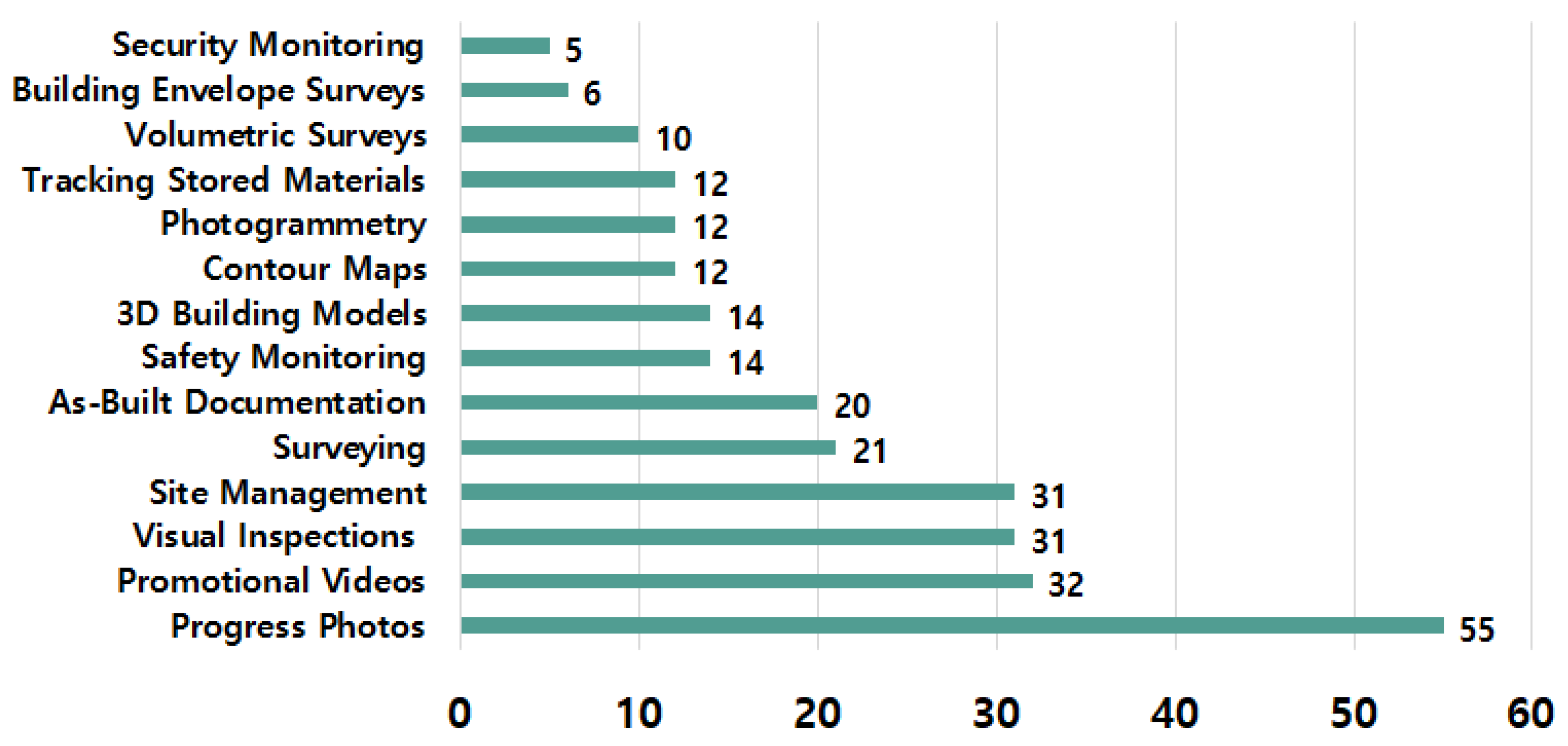
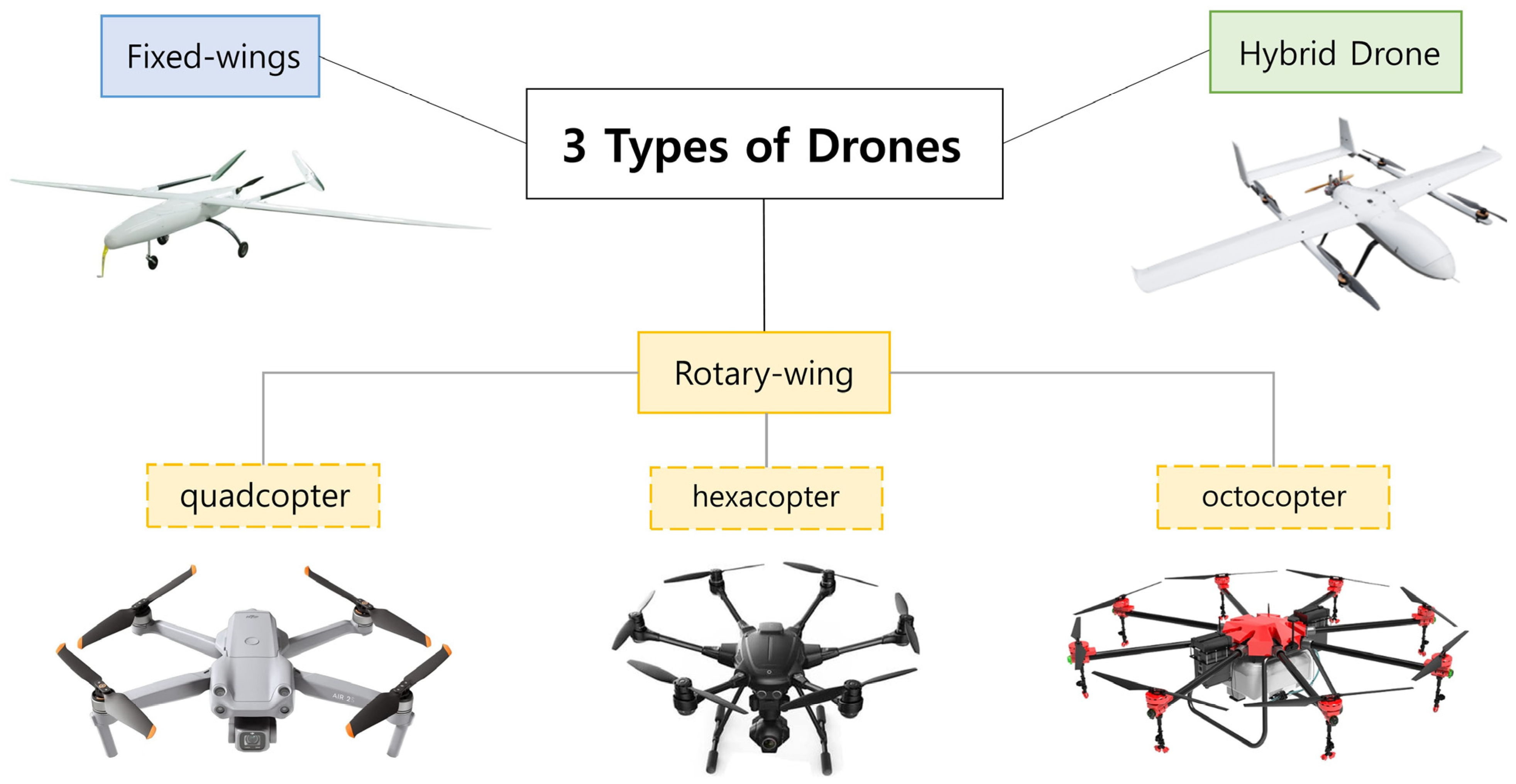
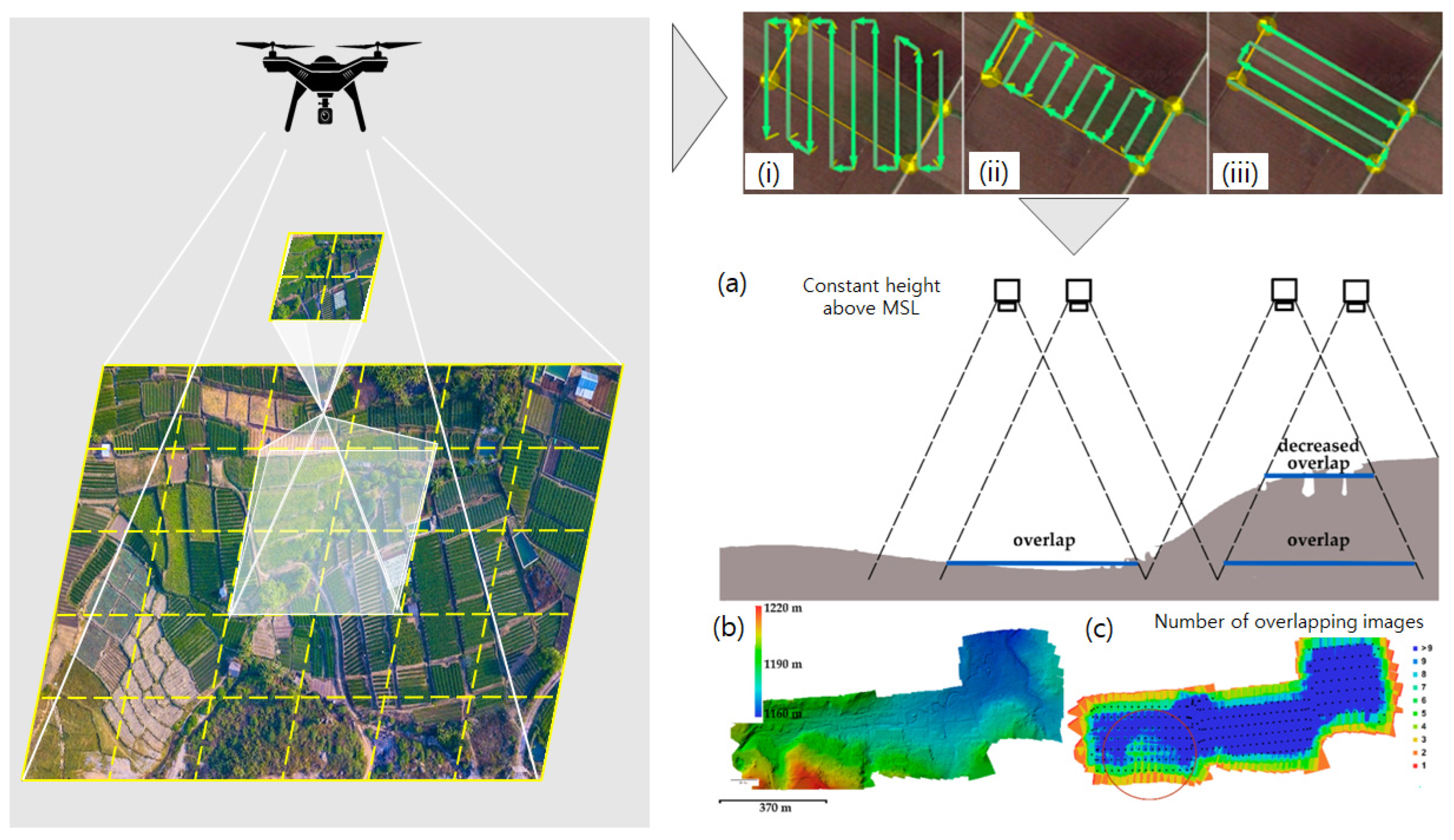
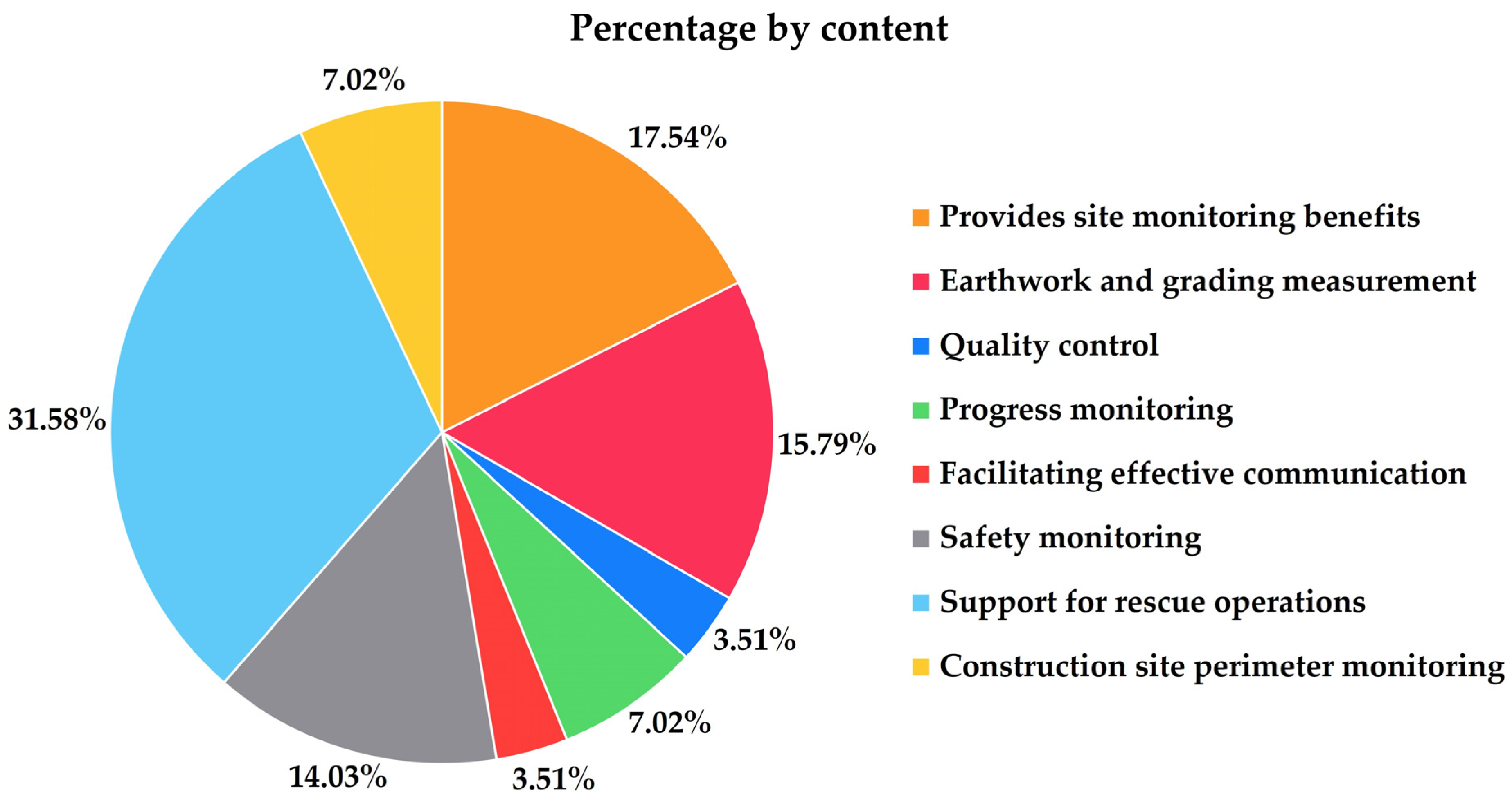


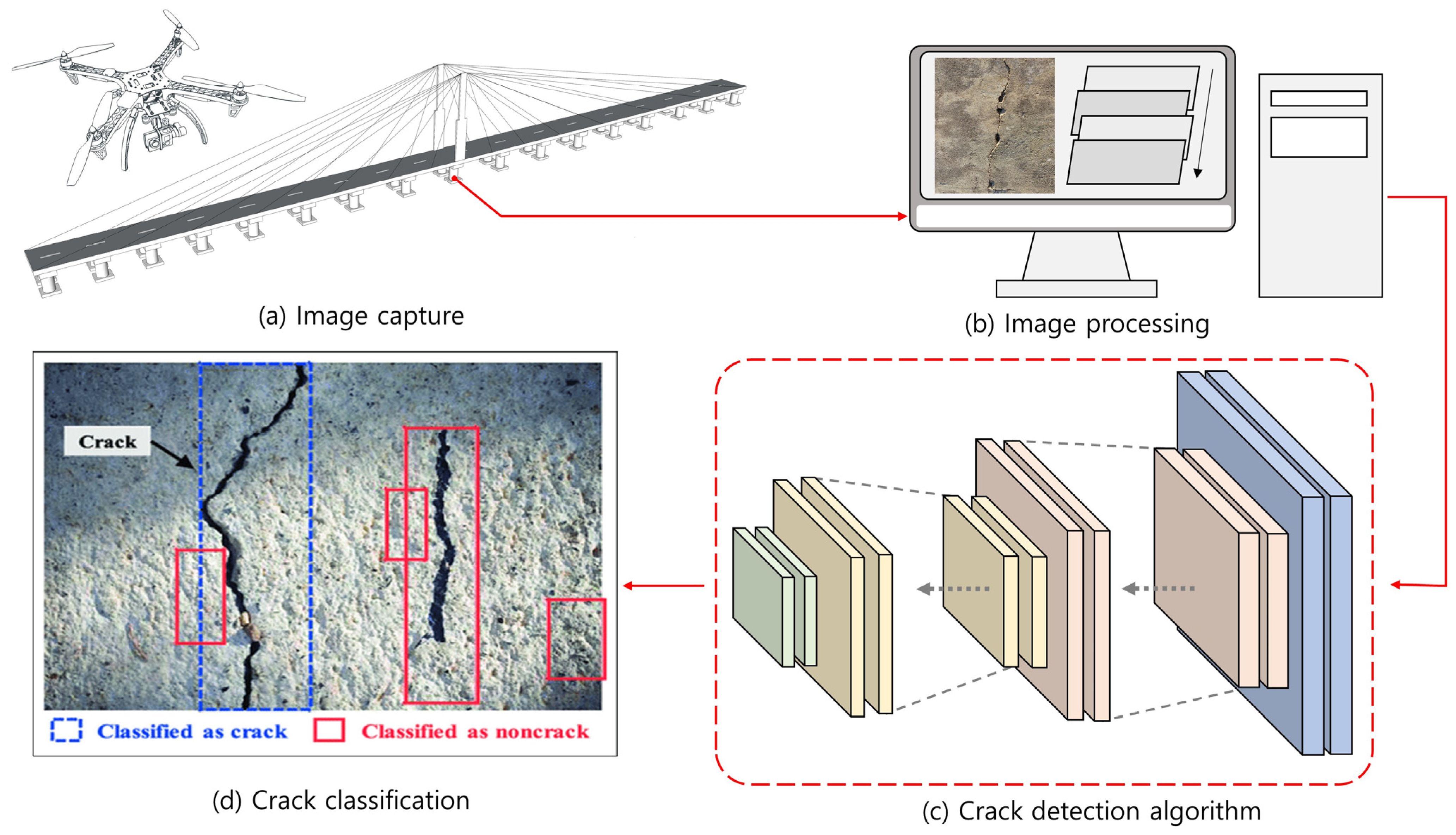
| Types of Drones | References | Brief Summary |
|---|---|---|
| Rotary-wing Drones | Calantropio, A et al. [17] Villanueva, J.R.E et al. [18] Templin, T et al. [19] Anders, N et al. [20] | Large-scale topographic surveys |
| Yi, W et al. [21] El Tin, F et al. [22] | Aerial inspections and monitoring of construction sites | |
| Sonkar, S et al. [23] | Capturing images in difficult weather | |
| Khan, S et al. [24] | UAV platform research | |
| Chae, M. H et al. [25] Sujit, P.B et al. [26] | Pilot’s expertise needs | |
| Jin, J. W et al. [27] | High initial cost of fixed-wing drones | |
| Fixed-wing Drones | Yang, H et al. [28] | Detailed inspections available |
| Altınuç, K. O et al. [29] | Safe take-off and landing scenarios in case of failure | |
| Freimuth, H et al. [30] Kim, S.S. [31] | Accessible for small-scale civil engineering projects or businesses with limited resources | |
| Deng, C et al. [32] | Limited flight time | |
| Boon, M.A et al. [33] Thibbotuwawa, A et al. [34] Eck, C. [35] Li, X et al. [36] | Structural issues impact quality and stability | |
| Al-Rawabdeh et al. [37] Jacob-Loyola, N et al. [38] Motawa, I. et al. [39] Khaloo, A et al. [40] Lindner, G et al. [41] | High-resolution mapping, limiting advanced data collection | |
| Hybrid Drones | Panigrahi, S et al. [42] Gunarathna, J.K et al. [43] | Benefits of long flights |
| Saeed, A.S et al. [44] Yuksek, B et al. [45] | Increase detailed data collection | |
| Nguyen, K.D et al. [46] | Designed with numerical simulations |
Disclaimer/Publisher’s Note: The statements, opinions and data contained in all publications are solely those of the individual author(s) and contributor(s) and not of MDPI and/or the editor(s). MDPI and/or the editor(s) disclaim responsibility for any injury to people or property resulting from any ideas, methods, instructions or products referred to in the content. |
© 2023 by the authors. Licensee MDPI, Basel, Switzerland. This article is an open access article distributed under the terms and conditions of the Creative Commons Attribution (CC BY) license (https://creativecommons.org/licenses/by/4.0/).
Share and Cite
Choi, H.-W.; Kim, H.-J.; Kim, S.-K.; Na, W.S. An Overview of Drone Applications in the Construction Industry. Drones 2023, 7, 515. https://doi.org/10.3390/drones7080515
Choi H-W, Kim H-J, Kim S-K, Na WS. An Overview of Drone Applications in the Construction Industry. Drones. 2023; 7(8):515. https://doi.org/10.3390/drones7080515
Chicago/Turabian StyleChoi, Hee-Wook, Hyung-Jin Kim, Sung-Keun Kim, and Wongi S. Na. 2023. "An Overview of Drone Applications in the Construction Industry" Drones 7, no. 8: 515. https://doi.org/10.3390/drones7080515
APA StyleChoi, H.-W., Kim, H.-J., Kim, S.-K., & Na, W. S. (2023). An Overview of Drone Applications in the Construction Industry. Drones, 7(8), 515. https://doi.org/10.3390/drones7080515






